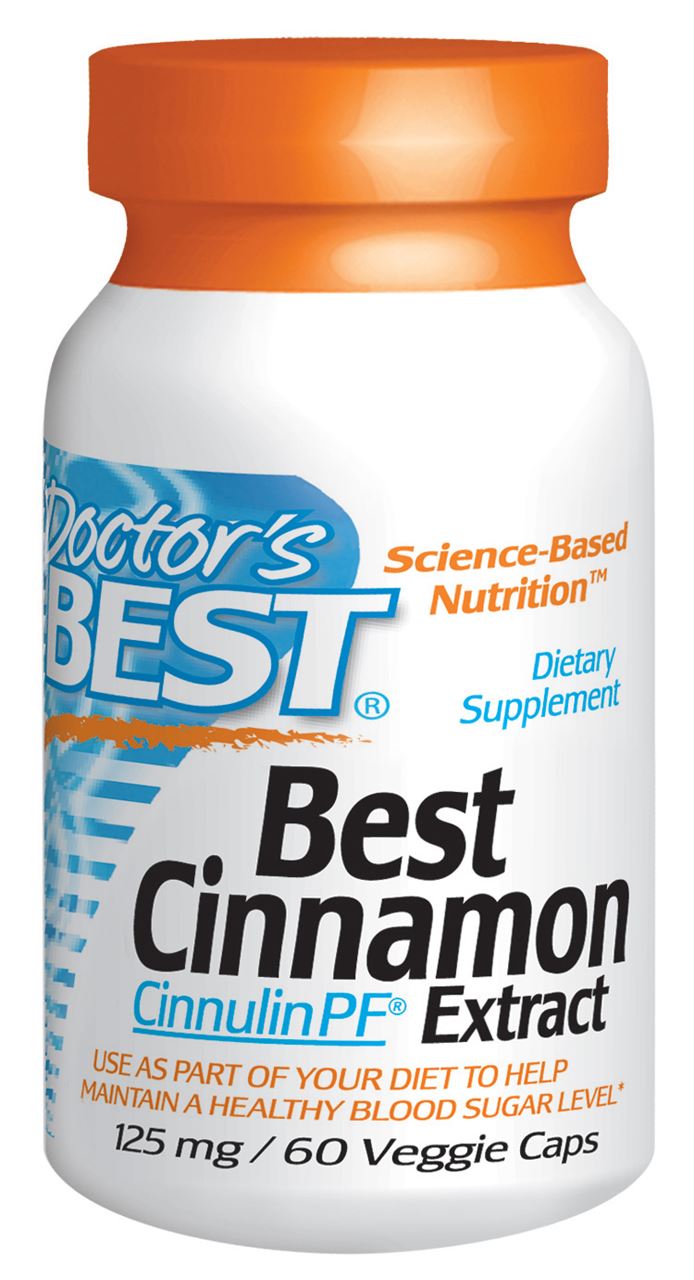FEATURES AND BENEFITS
- Helps maintain a healthy blood sugar level.
Doctor's Best Cinnamon Extract is Cinnulin PF® a patented, water-soluble extract of Cinnamon (species Cinnamomum burmannii) that contains Type-A polymers.
Recent research has revealed that procyanidin Type-A polymers in cinnamon bark help maintain the body's ability to metabolize glucose in a healthy way.
Ingredients
Active ingredient per capsule:
Cinnamon back extract 125mg
Other ingredients:
Modified cellulose (vegetarian capsule), cellulose, magnesium silicate, silicon dioxide, magnesium stearate (vegetable source).
Directions
Adults: Take 1 capsule before or during a meal, twice daily.
Benefits
Use as Part of Your Diet to Help Maintain a Healthy Blood Sugar Level
In Vitro and Animal Studies
Research has revealed that a number of herbs and spices have blood sugar metabolizing activity.2 In a study published in 2000 by the U.S. Department of Agriculture (USDA), cinnamon demonstrated the greatest ability to stimulate healthy cellular glucose metabolism among 49 botanicals tested.3
In a 2001 study, researchers at the USDA’s Human Nutrition Research Center showed that bioactive compounds in cinnamon facilitate glucose metabolism and storage in fat cells.4 These compounds stimulated glucose uptake into cells and increased glycogen (stored glucose) production via activation of the enzyme, glycogen synthase.
The bioactive compounds in cinnamon appear to have their impact at the level of certain cellular receptors. A physiological mechanism involved in blood sugar control and storage is characterized by dephosphorylation of specific cellular receptors.5 Enzymes called “protein tyrosine kinases” (PTPases) are believed to decrease receptor phosphorylation.6 Cinnamon compounds have demonstrated the in vitro ability to inhibit PTP-1 and increase autophosphorylation of these same receptors7, thereby supporting healthy blood sugar metabolism.
In an animal study, cinnamon (cassia) extract was administered to rats for three weeks. Following this, the rats were infused with insulin and glucose to assess their insulin response. Increased phosphorylation of cellular receptors responsible for sugar metabolism was observed in skeletal muscle of these rats, suggesting that cinnamon has the ability to enhance glucose uptake.8
Until recently, the precise molecular structure of the bioactive compounds in cinnamon had not been clearly defined. The USDA has now determined that the bioactive compounds in cinnamon are water-soluble procyanidin Type-A polymers of catechin and epicatechin. In a 2004 study, type-A polymers were isolated from cinnamon and characterized by nuclear magnetic resonance and mass spectroscopy. Type-A polymers were found to increase in vitro insulin activity by a factor of 20. Type-A polymers also exhibited antioxidant activity, as measured by inhibition of free radical production in platelets. These results suggest that, in addition to regulating glucose metabolism, cinnamon may help protect cell membranes by countering oxidation.9
HUMAN CLINICAL TRIALS
Cinnamon is known to possess blood sugar supportive effects when used as a component of the diet. Cinnulin PF®, of course, is an extract of cinnamon that contains high levels of Type A polymers. Because of its standardization, Cinnulin PF® is more potent than regular culinary cinnamon and is safer. Studies conducted using straight cinnamon, however, provide important insight into the overall beneficial effects of this herb. For example, a randomized, placebo-controlled human trial was conducted in which the effect of cinnamon on glucose and blood lipid levels was assessed. A total of 60 subjects were divided into six groups administered 1, 3, or 6 grams of whole cinnamon powder daily, in 500 mg capsules, or equal numbers of placebo capsules. The cinnamon or placebo capsules were consumed for two periods of 20 days each. Serum biomarkers were measured after 20 days, 40 days and again at the end of a 20-day wash-out period, during which neither cinnamon nor placebo was consumed.
In combination with dietary practices, cinnamon at three different doses showed significant support in maintaining healthy blood sugar levels. The placebo groups showed no significant changes. Cinnamon was also shown to enhance the ability to maintain healthy blood levels of triglycerides and cholesterol that are already in the normal range. The overall results of this trial demonstrate that cinnamon helps maintain healthy blood glucose and lipid levels with a daily intake of as little as 1 gram of whole cinnamon powder, and that this low dose may be just as useful as the higher doses of 3 and 6 grams.10 Since Cinnulin PF® is an extract of cinnamon, lower doses of this unique extract have been shown to have similar effects.
A twelve-week study published in 2006, for instance, found that Cinnulin PF® enhanced blood sugar control and moderately supported blood pressure levels that were already within the normal range. The study involved twenty-two volunteers who were supplemented with either Cinnulin PF® or placebo daily for twelve weeks. The Cinnulin PF® group received a dose of 500 mg daily. In addition to helping maintain healthy blood sugar and blood pressure levels, the group consuming Cinnulin PF® also exhibited decreased overall body fat.13 Thus, Cinnulin PF® appears to be a useful and safe product for reaping the benefits of cinnamon supplementation.
Scientific References
- Manniche, L. An Ancient Egyptian Herbal. 1989, Austin,TX: University of Texas Press.
- Khan A, Bryden NA, Polansky MM, Anderson RA. Biol Trace Elem Res 1990;24(3):183-8.
- Broadhurst CL, Polansky MM, Anderson R. J Agric Food Chem 2000;48(3):849-52.
- Jarvill-Taylor KJ, Anderson RA, Graves DJ. J Am Coll Nutr 2001;20(4):327-36.
- Nadiv O, Shinitzky M, Manu H, others. Biochem J. 1998;298(Pt 2):443-50.
- Begum N, Sussman KE, Draznin B. Diabetes 1991;40(12):1620-9.
- Imparl-Radosevich J, Deas S, Polansky MM, others. Horm Res 1998;50:177-182.
- Qin B, Nagasaki M, Ren M, others. Diabetes Res Clin Pract 2003;62(3):139-48.
- Anderson R, Broadhurst CL, Polansky MM, others. J Agric Food Chem 2004; 52(1):65-70.
- Khan A, Safdar S, Muzaffar M, others. Diabetes Care 2003;26(12):3215-18.
- Duke, JA. Handbook of Phytochemical Constituents of GRAS Herbs and Other Economic Plants. 1992. Boca Raton, FL: CRC Press.
- Botanical Safety Handbook. American Herbal Products Association. McGuffin M, et al., eds. 1997; Boca Raton, FL: CRC Press.
- Ziegenfuss TN, Hofheins JE, Mendel RW, others. J Int Soc Sports Nutr 2006 Dec 28;3:45-53.

